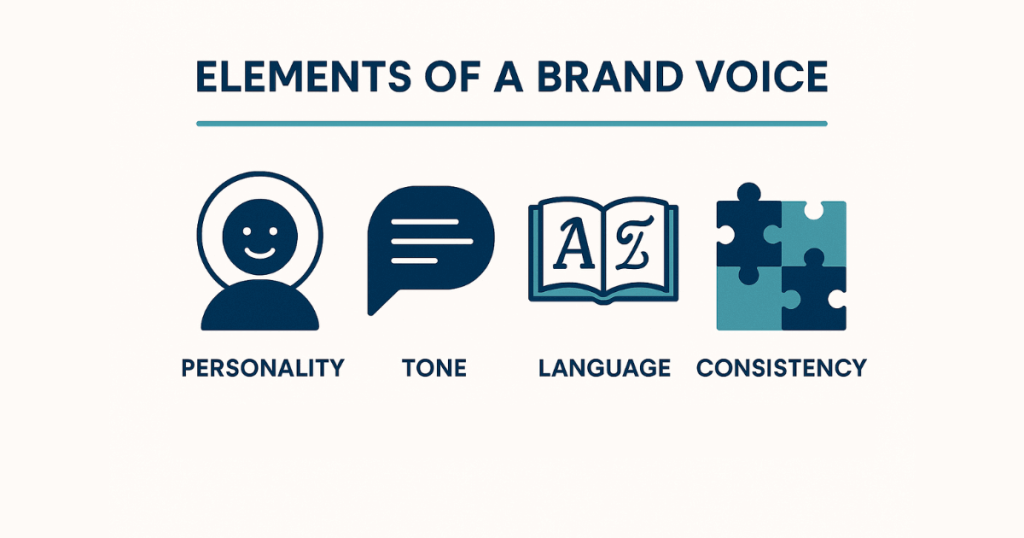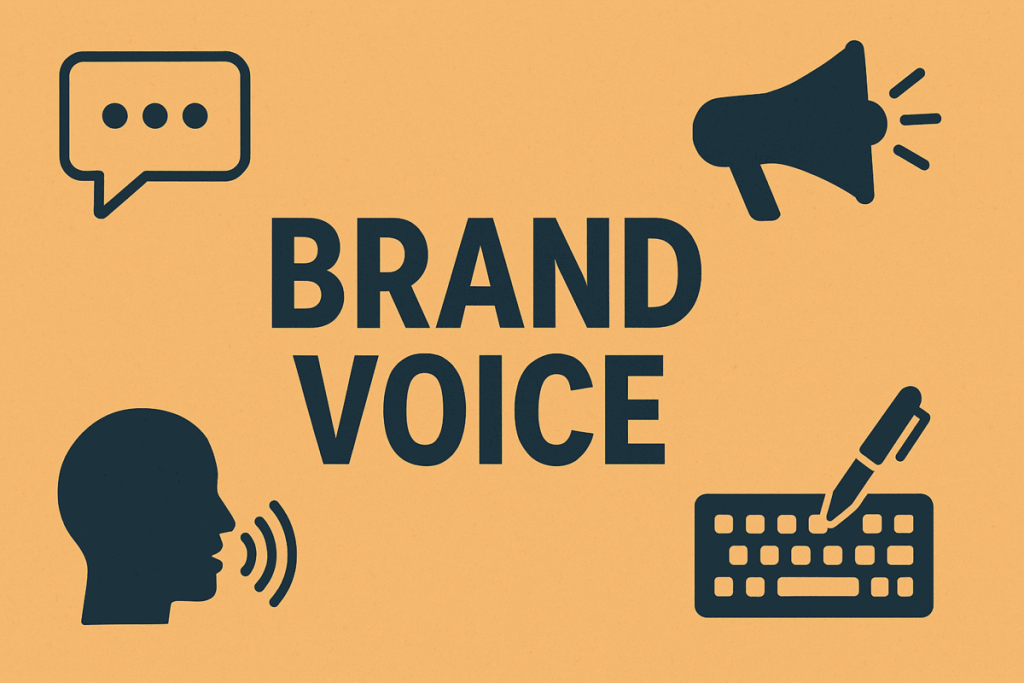When you hear your favorite brand, what do you think? Maybe it’s the whimsical tone of their ads, how they message on social media, or express their values. It all comes back to a primary marketing principle: brand voice.
A strong brand voice is the basis of consistent and impactful communication. It allows brands to connect with their audience on a more meaningful level by demonstrating who they are, what they stand for, and why they are different. In this blog, we will dive into all you need to know about brand voice, including its key elements, how to develop it, and real-world examples of brands that leverage it, and ways to measure the success of your efforts in this area.
Elements of A Brand Voice

A powerful brand voice is so much more than pretty words or a clever tagline. It’s the presentation of a brand’s personality, values, and mission through language. But what, exactly, goes into a brand’s voice?
A clear and consistent brand voice helps brands like Full Circle Market Natural connect with environmentally aware consumers through authentic messaging.
Personality
Personality is the core of brand voice. This is what makes your brand human-like. Ask yourself questions like:
- If my brand were a person, what would it do?
- Would it be formal and high-brow or low-key and friendly?
- Is it inspirational, like Nike, or sassy, like Wendy’s?
Your brand’s personality means that, wherever or however you speak, your audience is left feeling like they’ve found a new friend.
Tone
Tone dictates how your brand talks in various situations. And though the voice may stay largely the same, the tenor of the writing may change depending on the context. For example:
- A customer complaint may necessitate both empathy and professionalism.
- A new product launch, by contrast, might demand adrenaline and excitement.
It gives you the perspective of when to shift your tone, so you remain relatable while maintaining your brand’s voice.
Language
Each brand speaks specific words, phrases or even slang in order to communicate. These word choices make your brand pop. For instance:
- Soft drink maker Coca-Cola is using inspiring and emotional language.
- Apple likes things simple and classy.
The right words speak to the identity of your brand and speak directly to your desired audience.
Consistency
Whether your brand shows up on email, press releases, social media posts, or anywhere else, it should always sound the same. This level of consistency is what builds trust and helps people recognize your brand; it makes your image feel safe and comfortable.
How to Develop a Brand Voice
When you’re in charge of defining and capturing your brand’s voice, it can be overwhelming at first, but there is some real thinking and methodology that goes into it. So, how can you put a clear, effective voice to your brand’s identity? Here are 5 key steps to follow. Creating a brand voice. Each brand that has a unique persona, point of view, and positioning has to have a different guardian tone.
Define Your Target Audience
Knowing your audience is key in deciding how to communicate. Are you talking to corporates? Gen Z consumers? New parents? Your language, tone, and personality in your voice should be the same voice that the people you want to reach have.
Define Your Core Values and Mission
Ask yourself:
- What is your brand’s mission?
- How do you want to make your audience feel when they consume your content?
Your brand voice needs to be shaped by your values and mission. For instance, a sustainable brand might leverage a voice that’s passionate and conscious, while a tech startup may value innovation and excitement.
Evaluate Your Existing Communication
Aggregate some of the different ways that your brand communicates across channels. Look for patterns:
- Do your emails feel warm and inviting while your social media posts are robotic?
- Do you sound like a completely different person on different platforms?
By seeing where you’re at right now, you can also see inconsistencies and room for improvement.
Create a Brand Voice Chart
A brand voice chart will identify traits of your voice with examples so your team can follow along. For instance:
Voice Age: Young
Dialect or Accent: None
Language: English
Other: Many Many Voices
Type: Animation & Comedy.
Example: “Hey there! Thanks for signing up. We’re thrilled to have you!”
Not This: “You are signed up. Thank you for joining.”
This map provides a reference for maintaining consistency among your departments and campaigns.
Test and Refine
Begin flexing your new brand voice with smaller campaigns or upstart platforms. Collect feedback and see how your readers react. Tune and modulate your voice and find the right nuance.
Successful Brand Voices
And occasionally, the best way to learn a concept is to witness it play out. And here are some examples of brands getting it right with their brand voice:
Nike
Voice persona: Inspirational and empowering.
Example: “Just Do It.”
Nike’s voice appeals to the aspirations of its audience, positioning the brand as a co-pilot on their fitness journey.
Wendy’s
Voice: Witty - cheeky, comedy (Borderline Sarcasm added), scratchy and female.
Example (on Twitter): “We beef people, not sandwiches.”
Wendy’s has created an unusual Twitter identity using its razor-edged wit and humor, particularly appealing to younger customers.
Tesla
Voice Tone: Trend-setting and forward-thinking.
Example (Elon Musk): “Tesla’s mission is to accelerate the world’s transition to sustainable energy.”
Tesla uses a voice that resonates with its brand entirely, and provokes both trust and anticipation in people who want progress.
Assessing the Impact of a Brand Voice

A brand voice may be essential, but how do you know if it’s effective? Here are some concrete ways to assess its impact:
Engagement Metrics
Track the number of likes, shares, comments, and click-throughs of your communications. When people are engaging more with content from your page, it’s an indication that your brand voice is connecting.
Customer Feedback
Listen to the conversation your audience is having about your brand. What do consumers say about your tone: that it’s friendly, encouraging? You can also gather insights from reading reviews and participating in social media conversations.
Brand Recognition
Has your voice been a factor in your brand’s success? Simply, an even voice results in greater recall, meaning more differentiation for your brand in a noisy marketplace.
Sales and Conversion Rates
See what your new way of communicating does for sales. You may have heard the fact that changing the copy/language makes a world of difference with email campaigns, with click-through and conversion rates.
Internal Consistency
Keep track of how well your team follows the brand voice guidelines. Are all employees throughout the various departments speaking with one voice? Reliability is key to establishing trust over the long term.
Create Your Own Voice and Credibility
A strong and uniformed brand voice supports your business to differentiate itself, create trust with your audience, and lay the foundation for lasting relationships. It’s more than just marketing; it’s about crafting how your audience sees and feels your brand.
Create a voice that is representative of your values, that connects with your audience, and that can be heard consistently from all channels. It’s not just shares and likes that you will notice the results of, but customers who believe and feel in line with your company.
Need a little guidance creating your brand voice? Get in touch today to learn how to create a refreshing personality.




